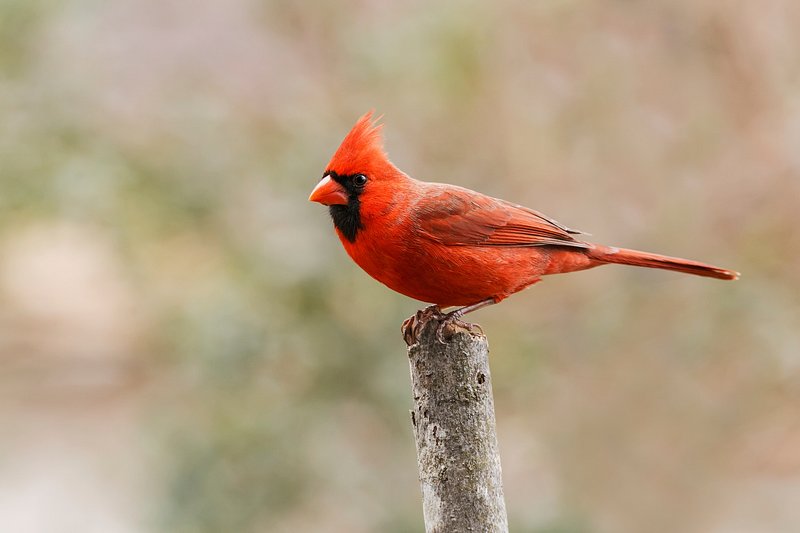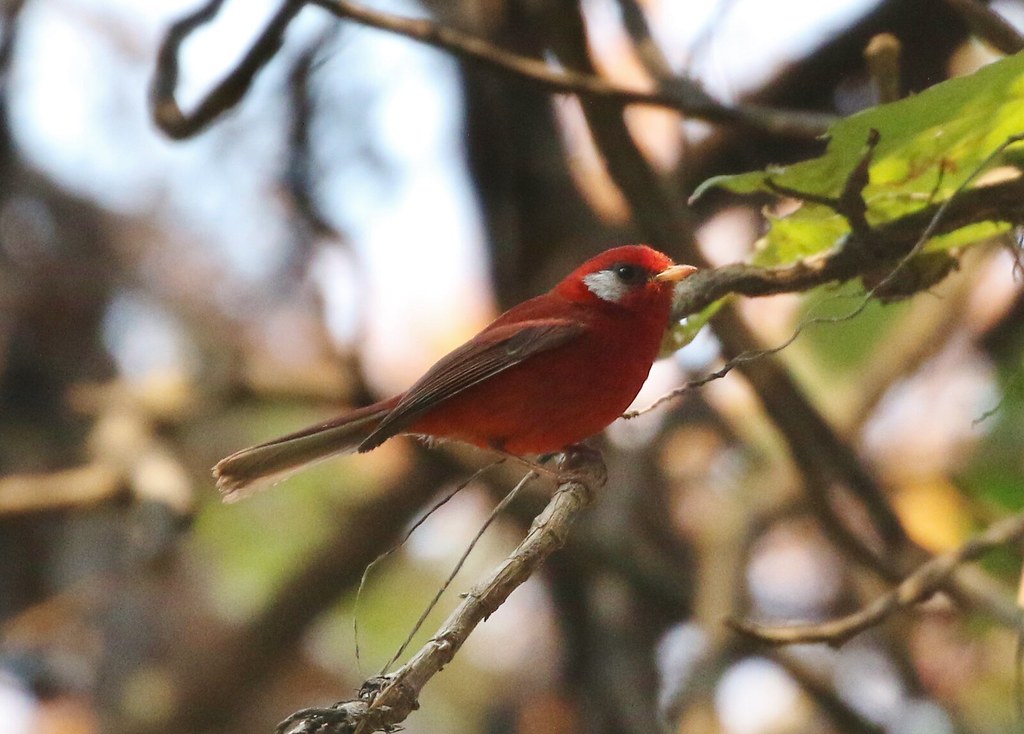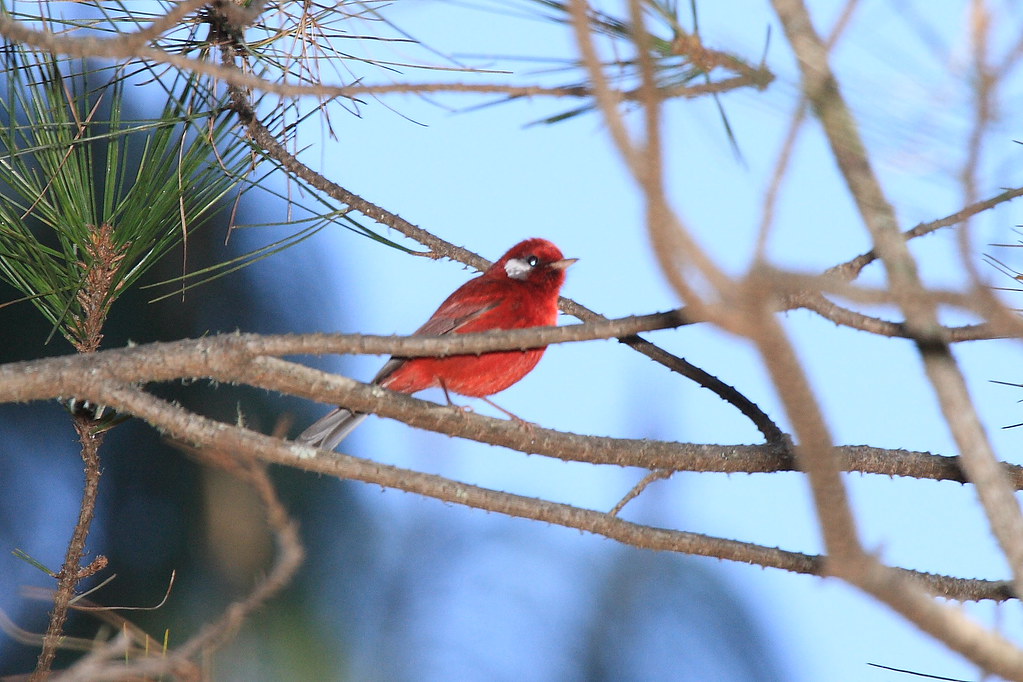Discover the vibrant world of red warbler! Explore their habitat, behaviors, and conservation efforts. Your guide to spotting, learning, and protecting these beautiful birds.
Introduction
Overview of Red Warbler
The red warbler, scientifically known as Cardellina rubra, stands as an unmistakable avian marvel within the highland realms of Mexico. Measuring between 12.5–13.5 cm (4.9–5.3 in) and weighing 7.6 to 8.7 g (0.27 to 0.31 oz), this vibrant species, adorned in bright red plumage, captivates both ornithologists and nature enthusiasts alike.
Significance and Habitat
Its significance spans beyond ornithology, embodying a crucial ecological cog in the high-altitude ecosystems of humid conifer forests, pine-oak woods, and adjoining brushy regions. Within these landscapes, the red warbler thrives, weaving its presence into the tapestry of native flora and fauna.
Historical Background
Endemic to Mexico’s highlands, this species carries a rich historical tapestry. However, it’s not merely the historical narrative that elevates its importance but its pivotal role in sustaining the biodiversity within these regions across generations.
Exploring the Red Warbler signifies embarking on a journey that unfolds not just the bird’s biological significance but also its cultural and ecological relevance within the specific niche it calls home.
This introduction lays the foundation for comprehending the multidimensional essence of the red warbler, serving as a precursor to an in-depth exploration of its taxonomy, behavior, habitat, and conservation status.

Taxonomy and Characteristics of the Red Warbler
Taxonomic Classification
The taxonomy of the red warbler, Cardellina rubra, positions it within the New World warbler family Parulidae. This distinctive avian gem shares its taxonomic cluster with the pink-headed warbler, forming a captivating superspecies primarily concentrated in the highlands of Mexico. Its classification underlines not only its genetic ties but also its ecological and behavioral affinities within this distinctive avian clan.
Physical Description
Embodying an enchanting allure, the red warbler presents a striking visual spectacle. Adorned in vivid crimson plumage, it exhibits a slender frame, measuring 12.5–13.5 cm (4.9–5.3 in) in length and weighing between 7.6 to 8.7 g (0.27 to 0.31 oz). This compact passerine is distinguished by its delightful scarlet hue, augmented by subtle, contrasting auricular patches of silver or dark gray. Additionally, its slender physique, short wings, and a small, stubby bill all contribute to its distinctive physical traits.
Behavioral Traits
The red warbler’s behavioral repertoire is as fascinating as its physical splendor. Its vibrant hue isn’t merely an aesthetic attribute; it’s a beacon of activity within the dense, coniferous forests it calls home. Renowned for its active nature, this species traverses the highland canopies with agility, foraging amidst branches and foliage, lending an animated presence to these verdant habitats.
During the breeding season, its behavioral dynamics shift, unveiling a melodious side. Its trilling songs resonate through the forest, marking territories and courtship rituals. This behavioral adaptation showcases the red warbler’s multifaceted nature, weaving a tale of both visual and auditory charm within its habitat.
Exploring the taxonomy and distinct characteristics of the red warbler unfurls an understanding not just of its biological uniqueness but also its profound behavioral nuances.
Distribution and Habitat Preferences
Native Range
The red warbler’s native range is an exclusive domain within the highland landscapes of Mexico. Thriving amidst the pine-oak forests and adjacent brushy areas of these elevated terrains, this avian jewel claims its residence predominantly in the southern reaches of the Sierra Madre Oriental and Sierra Madre Occidental. Within these verdant realms, the red warbler carves a niche, favoring altitudes ranging from 2,000 to 3,500 meters (6,500 to 11,500 feet) above sea level.
Preferred Habitats
This species’ predilection for humid coniferous forests and pine-oak habitats unveils its affinity for the high-altitude climes. Within these habitats, the red warbler orchestrates a symphony of color, flitting through the dense foliage, its vibrant plumage complementing the verdant backdrop.
Beyond the allure of the forested heights, the red warbler exhibits an affinity for adjacent brushy areas. It showcases a penchant for niches within these ecosystems, offering an intriguing insight into its adaptive prowess.
Migration Patterns
While the red warbler primarily resides within the highlands of Mexico, certain migration patterns have been observed. During the breeding season, these vivacious avians embark on altitudinal migrations, venturing higher into the mountains to find suitable nesting sites and abundant food resources. Conversely, during winter months, they descend to lower elevations, seeking refuge in the pine-oak areas. Understanding these seasonal movements provides critical insights into their life cycle and ecological adaptations.
The distribution and habitat preferences of the red warbler delineate a portrait of an avian marvel, intricately intertwined with the unique ecosystems of Mexico’s highlands.
Feeding Habits and Diet
Foraging Behavior
The red warbler, an agile and adaptable species, exhibits intricate foraging behavior. Within its favored habitat of humid coniferous forests and pine-oak landscapes, this avian marvel navigates the dense foliage with finesse. Its foraging prowess primarily involves flitting among the branches and foliage, employing quick, darting movements to capture a diverse array of prey.
Foraging Techniques:
- Aerial Pursuit: The red warbler adeptly catches insects mid-flight, showcasing remarkable aerial agility.
- Foliage Gleaning: Engaging in a meticulous examination of foliage, the bird captures insects camouflaged within the leaves.
- Hawking: Employing swift and precise movements, it snatches prey from the air, showcasing an adept hunting technique.
Dietary Preferences
The diet of the red warbler is diverse and multifaceted, predominantly comprising insects, insect larvae, and spiders. This species’ adeptness at aerial pursuits allows it to capture flying insects mid-flight, showcasing remarkable precision and agility. Moreover, the bird exhibits a preference for insects residing within the foliage, showcasing adept foliage-gleaning behavior.
Notable Food Sources:
- Insects: Including beetles, moths, flies, and ants.
- Insect Larvae: Often found within the bark or leaves of trees.
- Spiders: Captured while scuttling among the branches or hiding within crevices.
Role in Ecosystems
As an integral member of the ecosystem, the red warbler plays a pivotal role in maintaining ecological balance. Its diet predominantly comprising insects aids in controlling pest populations, thereby exerting a regulatory influence on the ecosystem’s health. Additionally, its foraging habits contribute to nutrient cycling within the forested landscapes it inhabits, further reinforcing its ecological significance.
Understanding the feeding habits and diet of the red warbler unveils the intricate web of interactions it weaves within its habitat, highlighting its significance in maintaining the ecological equilibrium of its environment.

Breeding and Reproduction
Mating Behavior
The red warbler’s mating rituals are an intricate dance of courtship displayed amidst the verdant tapestry of its habitat. During the breeding season, the male warblers don a vibrant crimson plumage, signaling their readiness for courtship. Their distinctive calls resonate through the forest, marking territories and attracting potential mates. Intriguingly, these courtship displays often involve elaborate aerial performances, showcasing the male’s agility and vigor.
Courtship Displays:
- Vivid Plumage: The male’s vibrant red hue serves as a visual beacon to attract females.
- Ornate Songs: Engaging in melodic and varied songs, males showcase their vocal prowess.
- Aerial Acrobatics: Swift flight patterns and mid-air displays exhibit the male’s agility and stamina.
Nesting Habits
Once courtship culminates, the female selects a suitable nesting site amidst the dense foliage. Red warblers are known for their intricate nest-building endeavors. Constructed primarily from fine plant material, the nest forms a secure cradle for the forthcoming brood. These nests are often nestled within the dense canopies of coniferous trees, offering a protective cover from predators and the elements.
Nest Construction:
- Fine Materials: Building nests with grass, leaves, and soft plant fibers.
- Hidden Locations: Often placing nests among the dense branches or foliage.
- Careful Architecture: Crafting sturdy, cup-shaped structures to house the eggs and hatchlings.
Incubation Period and Offspring
Following the successful construction of the nest, the female warbler diligently tends to the eggs, carefully incubating them until they hatch. The incubation period lasts several days, and once hatched, the fledglings are altricial, requiring constant care and feeding from both parents. This nurturing phase is crucial for the young warblers’ development, ensuring their survival in the complex ecosystem they call home.
Understanding the intricacies of red warbler’s mating, nesting, and the care they invest in their offspring provides a glimpse into the fascinating world of avian reproduction, highlighting the species’ commitment to ensuring the continuity of its lineage.
Conservation Status and Threats
Current Conservation Status
The conservation status of the red warbler stands at a critical juncture, necessitating urgent attention and concerted efforts for its preservation. Classified under varying conservation lists based on geographic regions, this species faces diverse challenges across its range. While the International Union for Conservation of Nature (IUCN) assesses its status on a regional basis, several regional authorities also monitor and evaluate its standing.
Conservation Listings:
- IUCN Red List: Varied classifications across regions, ranging from ‘Least Concern’ to ‘Vulnerable.’
- National Assessments: Differing classifications based on regional conservation efforts and population trends.
Threats to Red Warbler Population
The red warbler confronts an array of threats, predominantly arising from habitat degradation, climate change, and human activities. Encroachment into its natural habitats, driven by human development, leads to habitat fragmentation and loss. Furthermore, altering climate patterns poses challenges, disrupting the delicate ecological balance that the red warbler relies upon for survival. Predation, particularly by invasive species, also contributes to declining population numbers.
Key Threats:
- Habitat Loss: Clearing of forests for agriculture and urbanization.
- Climate Shifts: Altered weather patterns affecting breeding seasons and habitats.
- Invasive Species: Predation and competition from non-native species.
Conservation Efforts and Initiatives
Efforts to safeguard the red warbler encompass a spectrum of strategies aimed at habitat restoration, community engagement, and policy advocacy. Conservation initiatives focus on preserving vital habitats, implementing sustainable land-use practices, and raising awareness about the species’ significance. Collaborative projects involving local communities, scientists, and governmental bodies play a pivotal role in securing the species’ future.
Conservation Measures:
–Habitat Restoration: Rehabilitating and protecting key habitats.
- Community Engagement: Involving local communities in conservation initiatives.
- Policy Advocacy: Influencing governmental policies for habitat preservation.
Understanding the current conservation status and the imminent threats faced by the red warbler emphasizes the urgency for proactive measures and collective action to ensure the sustained existence of this avian species.
Interactions with Humans and Culture
Cultural Significance
The red warbler holds a significant place in various cultures, symbolizing diverse meanings across regions. In indigenous folklore, it often represents vitality, resilience, and the interconnectedness of nature. Revered for its vibrant plumage and melodious calls, the bird finds mention in myths, stories, and traditional art forms, embodying different virtues in different cultural contexts.
Cultural Representations:
- Symbol of Vitality: Often portrayed as a symbol of energy and vitality due to its vibrant coloration.
- Resilience and Adaptability: Revered for surviving in diverse habitats, signifying adaptability and resilience.
Human Impacts on Red Warbler
Human activities exert notable impacts on the red warbler, directly influencing its habitats, behaviors, and population dynamics. Habitat alteration, primarily due to deforestation and urban expansion, disrupts the bird’s natural habitats. Additionally, anthropogenic factors like pollution, pesticide use, and collision with man-made structures pose significant threats to its existence.
Human-Induced Threats:
- Habitat Loss: Clearing of forests for agricultural and developmental purposes.
- Pollution and Pesticides: Contamination affecting food sources and habitats.
- Collision Risks: Impact on infrastructure like buildings and communication towers.
Conservation Outreach and Education
Efforts aimed at conserving the red warbler often involve extensive education and outreach programs directed toward communities, schools, and conservation enthusiasts. These initiatives focus on raising awareness about the species’ significance, fostering empathy, and imparting knowledge about conservation practices. Engaging the public in these programs helps garner support and encourages proactive measures for the bird’s preservation.
Conservation Education Initiatives:
- Community Engagement: Collaborative efforts involving local communities in conservation projects.
- School Programs: Incorporating red warbler conservation in educational curriculums.
- Awareness Campaigns: Utilizing media and outreach events to inform and mobilize public support.
Understanding the diverse cultural representations of the red warbler and recognizing human impacts on this species underscore the importance of fostering symbiotic relationships between humans and nature for its long-term conservation.
FAQs about Red Warblers

Are Red Warblers Poisonous?
Red warblers are not poisonous. These small, colorful birds pose no threat to humans or other animals in terms of toxicity. Their brilliance in plumage and lively presence in various habitats do not correlate with any toxic or harmful properties.
What Do Red Warblers Sound Like?
The red warbler’s song is a melodious, high-pitched, and often repetitive series of chirps, whistles, and trills. These birds use their vocalizations for communication, especially during the breeding season. The songs vary between individuals and can contain a mix of musical notes, making their sounds distinctive and recognizable.
Characteristics of Red Warbler Eggs
The eggs of red warblers are typically small, oval-shaped, and exhibit a white to cream-colored base with speckles or spots in various shades—often brown, gray, or reddish. These markings are unique to each clutch and serve as protective camouflage within their nesting habitats.
Understanding these frequently asked questions provides insight into various aspects of red warbler behaviors and characteristics, aiding in their recognition and appreciation within their ecosystems.
Conclusion
Summary of Key Points
The red warbler, a vibrant and intriguing avian species, presents a multitude of captivating features. From its taxonomic classification to behavioral traits and habitat preferences, this small bird holds a significant place in the ecosystem.
Understanding its native range, preferred habitats, and migration patterns offers insights into its adaptability and survival strategies across diverse environments. Equally fascinating are its foraging behavior, dietary preferences, and role within various ecosystems, highlighting its ecological importance.
The intricate details of mating behavior, nesting habits, and incubation periods underscore the careful balance of breeding and reproduction within its life cycle. These facets not only shed light on the species but also contribute to our appreciation of its unique traits.
Future Prospects and Conservation Outlook
Considering the ongoing threats to the red warbler population and their habitats, proactive conservation measures are imperative. Enhancing awareness and implementing targeted conservation efforts are crucial to safeguarding this species from further decline.
Call to Action for Red Warbler Conservation
Engagement in habitat preservation, mitigating human impacts, and supporting conservation initiatives are pivotal actions for ensuring the long-term survival of the red warbler. Collaboration among researchers, conservationists, policymakers, and the public is essential to maintain and restore the ecological balance necessary for the red warbler’s sustained existence.
In conclusion, the red warbler’s enchanting presence in ecosystems deserves our attention, admiration, and concerted efforts toward its conservation and preservation for future generations.

2 thoughts on “Red Warbler: Unveiling Habitat & Behaviors for Bird Enthusiasts”
Comments are closed.